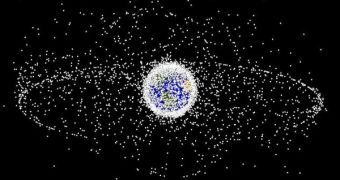Astronauts and space-agency officials have known for a long time that rocket, satellite and shuttle launches are leaving behind numerous pieces of debris in the low-Earth orbit. Over the past few years, they have tried to minimize their footprint on the space surrounding the planet, but seem to have failed. At a recent conference, it was predicted that the chances for impact between an asset launched for the Earth and a set of pieces of debris from the orbit would increase by 50 percent over the next ten years, and by more than 400 percent by 2059, NewScientist reports.
Speaking at the European Air and Space Conference, in Manchester, University of Southampton expert Hugh Lewis said that these were only conservative estimates, and that the actual damage might be a lot worse. He added that the increased danger would force space agencies to add more countermeasures to their space vehicles, which would, in turn, make them more expensive, and thus hinder space exploration. According to Lewis, the orbit is littered with spent rocket stages, dead spacecraft and other, smaller parts.
Just a few years ago, China demonstrated it had the ability to destroy satellites in orbit, by destroying one of its communication devices. The explosion had massive repercussions, creating a large number of small, fast pieces of debris that could pierce through solid metal as if it were paper. A collision between an American and a Russian satellite earlier this year also added to the amount of fine space junk currently in orbit. It is estimated that thousands of new pieces of debris were added to orbit by these two collisions alone. Depositing garbage in orbit has been going on nonstop since 1957.
According to conservative estimates from the US air force Space Command, there are currently more than 500,000 small fragments of junk in orbit, in addition to the 19,000 pieces that are larger than ten centimeters across, and that are being constantly surveyed. Of all these bodies, only 800 are working satellites, as in spacecraft that actually do something. The rest just spin around the planet at very high speeds, and create hazards for space telescopes and shuttle missions.

 14 DAY TRIAL //
14 DAY TRIAL //